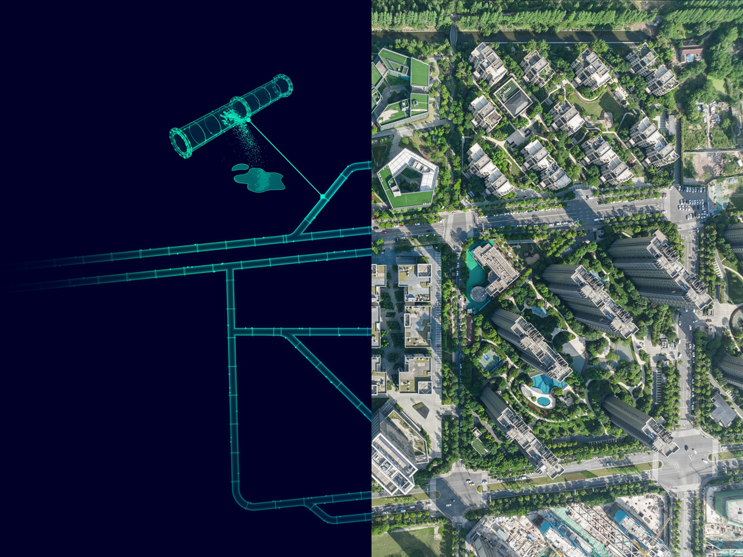SWAN Corner: A Dynamic Trio For Water Networks — Smart Metering, Hydraulic Modeling, And AI
By Adam Cartwright and Raul Martinez Navas

Non-revenue water is a global problem: Around 30% of drinking water is lost on its way to the consumer, imposing a huge economic loss that increases the overall cost of water treatment. The good news: By combining smart metering, hydraulic modeling, and artificial intelligence (AI), utilities can effectively increase their operational efficiency, reduce water losses, and optimize the utilization of increasingly scarce resources.
For a very long time, water utilities have treated water losses in their networks as a sort of “necessary inconvenience,” based on the conviction that reducing non-revenue water (NRW), that is, water that is pumped into the water supply but is not or cannot be billed accordingly, will take time, is extremely costly, and may pay off within a reasonable timespan. However, technological advances are now challenging these long-held perceptions: By applying proven, easy-to-use digital solutions, utilities can now make the best use of data they already have from sensors and from hydraulic models — and the market is already adopting these solutions, as a recent market report1 demonstrates: The authors state that “AI-enabled solutions are giving utilities a new tool in their arsenal to reduce leakage and commercial losses, prioritise pipe and meter replacement and manage sewers.” The report further states that the adoption rate of AI varies across regions and sectors, but there is a general trend that the drinking water network sector will continue to lead the way.
The main reason for this is that leak and commercial losses reduction in the water supply will offer a clear return on investment: Utilizing data and advanced data analysis enables utilities to analyze the entire water cycle and learn a great deal about how much water they are losing and why. It also helps them to focus their resources on those areas where a reduction in NRW will have the largest impact in terms of resource efficiency and cost-effectiveness. By employing these solutions, some utilities have managed to reduce NRW by up to 50%. Additionally, they have reduced leakage detection time and costs for in-field crews, minimized penalties and collateral damage through early leak detection, increased revenue by preventing commercial losses, and optimized their investment plans for pipe and meter replacement.
A Compelling Business Case
Two examples of how smart water loss detection will immediately improve the bottom line of utilities can be found in Spain. Servicios de Txingudi, the public utility responsible for the water supply in the northern Spanish municipalities of Irun and Hondarribia, is leveraging the SIWA Leak Finder app to address water loss. SIWA Leak Finder is a software solution for detecting and pre-locating leaks in water transport and distribution networks by using artificial intelligence to analyze real-time flow data. Thanks to AI, the system is capable of recognizing seasonal patterns influenced by tourism and weather conditions. Servicios de Txingudi implemented SIWA Leak Finder across the entire network covering 285 km (187 miles) of pipes and trained the solution on a three-week dataset. Since then, SIWA Leak Finder detected over 10,000 events, including leaks, pressure issues, chlorine anomalies, sensor failures, data transmission problems, and theft — and has helped operators detect and repair leaks quickly while minimizing false alarms.

At EMAYA, the municipal public utility company that manages the water cycle for Palma de Mallorca, SIWA Meter Data Analytics has accompanied a smart metering implementation project with the aim of equipping 100% of Palma with smart meters. The solution was initially populated with data from almost 100,000 water meters with bimonthly readings. Historical readings were also included, as were key features of each water meter, such as meter size, type, installation date, and activity. In under three years, SIWA Meter Data Analytics has helped cut metering error by 23% (from 3.9% to 3%). What’s more, the solution optimizes meter replacement: meters replaced in line with the criteria showed eight times more revenue than with age-based replacements, which was the previous replacement criteria.
Enabling A Better Understanding Of Consumption And Networks
The challenges faced by Servicios de Txingudi and EMAYA are not just typical of utilities in Spain. Their problems were the same as those faced by many water operators worldwide: significant water losses, often caused by leaks that are hard or even impossible to detect with conventional methods, data inconsistencies, inefficient manual operations, a shortage of staff both in the office and in the field, and increasingly strict regulations and penalties. At the core of these issues is a lack of understanding on how AI can support water consumption knowledge and networks behavior. Adopting smart metering, hydraulic modeling, and AI-driven solutions can help utilities differentiate anomalies from normal consumption patterns: Smart metering enables timely data collection of water consumption. This data served as input for both hydraulic models and AI systems, moving beyond billing purposes to include leak detection, theft identification, and improvement of minimum night flows analysis. Using data from smart meters, connecting them to a hydraulic model via a network twin, and adding AI on top helps increase accuracy by simulating “what-if” scenarios, optimize sensor placement, and pre-locate leaks or operational anomalies. Artificial intelligence will enable utilities to classify anomalies, optimize operational performance, and improve data quality by detecting outliers and non-plausible data and filling gaps, enabling more reliable decision-making.
Generating Immediate Returns
The business benefits of a smart, data-driven approach to reducing non-revenue water are obvious: Utilities can reduce the amount of surplus treated water, which will lower operating costs and carbon footprint; they can maintain pipes and meters more efficiently; and they can better manage and protect resources. Utilizing advanced AI algorithms, solutions such as SIWA Leak Finder can identify leaks as small as 0.2 liters per second. This precision enables utilities to detect and address leaks promptly, minimizing water loss, collateral damage, and penalties. Analyzing smart and conventional water meters with advanced data analytics not only helps to detect leaks, but can also optimize meter replacement programs, with many utilities have found a return on investment of less than 12 months by replacing poorly performing meters. And finally, smart meter data management empowers water utilities and consumers with transparent and trustworthy information about meter performance and customer-side leakage, reduce costly billing errors, and strengthen consumer communication and trust.
Leaping Ahead With Proven Technologies
So why are adoption rates still low compared to other industries such as oil and gas, chemicals, and pharmaceuticals, just to name a few? One reason may be that utilities are concerned about the extent to which these technologies can be used with success and at a reasonable cost while ensuring high security standards. In fact, the water sector as a whole is often described as laggard in the adoption of digital technology. But the sector now has the unique opportunity to leap ahead: Advances in AI, software, and communications technologies are now bringing solutions to the market that can identify opportunities to reduce NRW at ever-decreasing costs. With an extensive portfolio of applications for leak detection, meter data management, asset management, cybersecurity, and process optimization, Siemens promotes the easy introduction and adoption of digital technologies for smart water distribution. Based on mature systems and solutions, smart, data-driven decision-making is now in the reach of every utility. By leveraging AI across integrated platforms, utilities can significantly reduce non-revenue water. Combining smart metering, hydraulic modeling, and artificial intelligence, utilities can now create a powerful ecosystem that enables water utilities to detect leaks with unprecedented accuracy, analyze consumption patterns in real-time, and optimize meter management for maximum efficiency.
References:
- Source: “Utilities call on AI to meet ever greater water and sewer network challenges”, Yujia Shen and Yingjia Qian, Global Water Intelligence Magazine, June 2024
 Dr. Adam Cartwright is the Director of Industry Strategy for Water and Wastewater Software at Siemens. In this role, he leads a cross-functional team of engineers, data scientists, and developers responsible for the global development of digital applications for the water and wastewater industry. Prior to joining Siemens, Dr. Cartwright held positions in the steel industry, the UK government where he specialized in the impact of climate change policies on businesses, and as the Head of Open Innovation for Siemens UK, where he supported nearly 200 collaborations with UK universities.
Dr. Adam Cartwright is the Director of Industry Strategy for Water and Wastewater Software at Siemens. In this role, he leads a cross-functional team of engineers, data scientists, and developers responsible for the global development of digital applications for the water and wastewater industry. Prior to joining Siemens, Dr. Cartwright held positions in the steel industry, the UK government where he specialized in the impact of climate change policies on businesses, and as the Head of Open Innovation for Siemens UK, where he supported nearly 200 collaborations with UK universities.
 Raul Martinez Navas is the Software Engineering Director for Water and Wastewater at Siemens AG. Prior to joining Siemens, he co-founded BuntPlanet in Spain, where as COO and CTO he led the digital transformation of water utilities in over 20 countries through the BuntBrain platform. Following Siemens' acquisition of BuntPlanet in 2023, he now leads the development of advanced software modules within the Siemens Water (SIWA) platform. Raul holds a degree in Industrial Automation and Electronics from the University of Navarra and an MBA from the University of Deusto, Spain.
Raul Martinez Navas is the Software Engineering Director for Water and Wastewater at Siemens AG. Prior to joining Siemens, he co-founded BuntPlanet in Spain, where as COO and CTO he led the digital transformation of water utilities in over 20 countries through the BuntBrain platform. Following Siemens' acquisition of BuntPlanet in 2023, he now leads the development of advanced software modules within the Siemens Water (SIWA) platform. Raul holds a degree in Industrial Automation and Electronics from the University of Navarra and an MBA from the University of Deusto, Spain.
SWAN, the Smart Water Networks Forum (SWAN), is the leading global hub for the smart water sector. A UK-based non-profit, SWAN brings together leading international water utilities, solution providers, academics, investors, regulators, and other industry experts to accelerate the awareness and adoption of “smart,” data-driven solutions in water and wastewater networks worldwide. Learn more at www.swan-forum.com.
